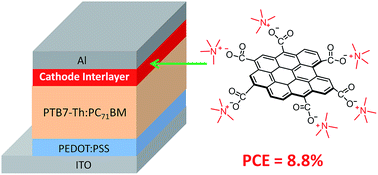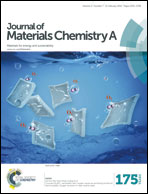Functionalized graphene quantum dots as a novel cathode interlayer of polymer solar cells†
Abstract
The cathode interlayer (CIL) plays an important role in maximizing the photovoltaic efficiency of polymer solar cells (PSCs). The principle to design organic/polymeric CIL materials is to functionalize π-conjugated skeletons with specific polar/ionic groups. Here, using the principle of organic/polymer CIL materials, we developed graphene quantum dots functionalized with tetramethylammonium at the edge (GQDs-TMA) to be used as a CIL for PSCs with good device performance. The peripheral tetramethylammonium groups can form an interfacial dipole with the cathode to decrease the work function. Graphene quantum dots are used as the π-conjugated skeleton because of their facile synthesis, high conductivity and good film-forming capability. As a result, using an active layer of PCDTBT:PC71BM, a power conversion efficiency (PCE) of 7.01% is achieved with GQDs-TMA as the CIL, much higher than that (<6.5%) with Ca, LiF, or ZnO as the CIL. PSCs with a conventional configuration using GQDs-TMA as the CIL and PTB7-Th:PC71BM as the active layer show a PCE of 8.80%, which is the highest reported so far for PSCs containing graphene materials. Moreover, GQDs-TMA can also work well when high work function metals (e.g. Ag, Au) are used as the cathode. To the best of our knowledge, this is the first report on solution-processed graphene derivatives as a CIL with excellent PSC device performance.


 Please wait while we load your content...
Please wait while we load your content...